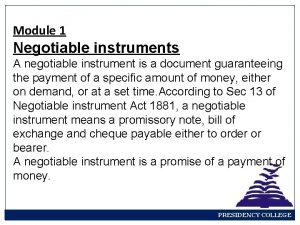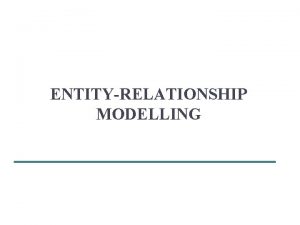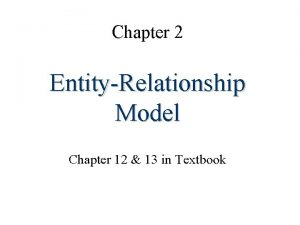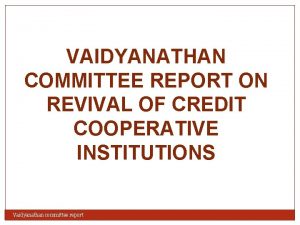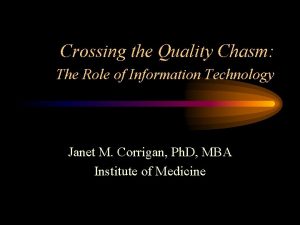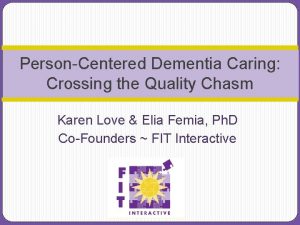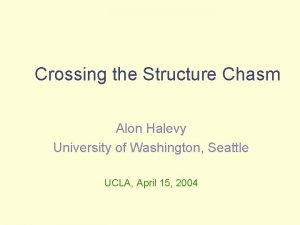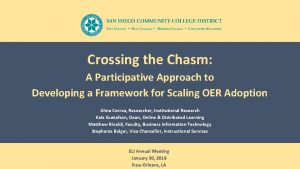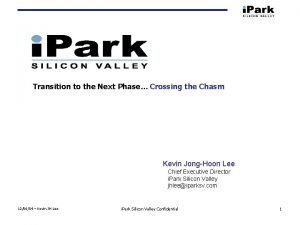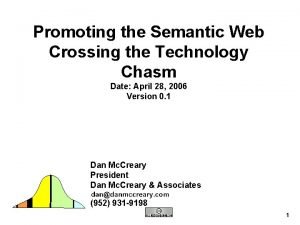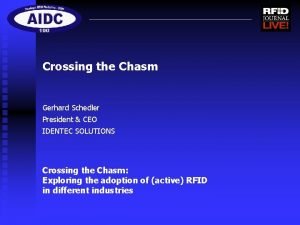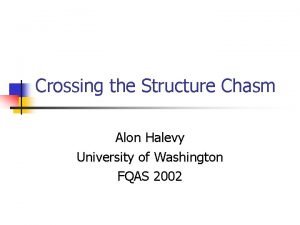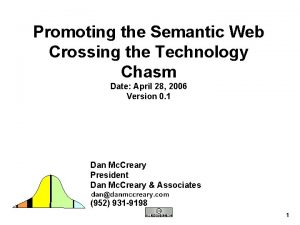Crossing the Quality Chasm Second Report Committee on


















- Slides: 18

Crossing the Quality Chasm Second Report Committee on Quality of Health Care in America To order: www. nap. edu 1

Studies Documenting the “Quality Gap” n n Literature reviews conducted by RAND u Over 70 studies documenting quality shortcomings Large gaps between the care people should receive and the care they do receive u true for preventive, acute and chronic u across all health care settings u all age groups and geographic areas (Schuster et. al. , MMFQ, 1998 ; updated 2000) 2

Medical Errors are a Serious Problem Over 35 studies documenting patient safety concerns u Tens of thousands of Americans are seriously harmed u Most errors occur because of system failures u 3

Major Forces Influencing Health Care Expanding Knowledge Base “Current practice depends upon the clinical decision-making capacity and reliability of autonomous individual practitioners, for classes of problems that routinely exceed the bounds of unaided human cognition. ” Daniel R. Masys, M. D. 2001 IOM Annual Meeting 4

Major Forces Influencing Health Care Chronic Care Needs n 40% of population have one or more chronic conditions n Chronic conditions account for more than twothirds of health care expenditures (RWJF, 1996) n 80/20 Rule: Limited number of conditions account for most of these health care expenditures 5

Delivery System Increasingly Inadequate n Dearth of clinical programs with necessary infrastructure n Chronic Care Delivery Model (Wagner, 1996) u u u Systematic approach Attention to information and self-management needs of patients Multi-disciplinary teams Coordination across settings and clinicians, and over time Unfettered and timely access to clinical information 6

Committee’s Conclusion The American health care delivery system is in need of fundamental change. The current care systems cannot do the job. Trying harder will not work. Changing systems of care will. 7

Five Part Agenda for Change § Commit to six aims for improvement § Adopt “ 10 rules” to guide the redesign of care § Implement effective organizational supports § Focus efforts on “priority conditions” § Create environment that fosters improvement 8

Aims For Improvement n Safe n Timely n Effective n Efficient n Patient-centered n Equitable 9

10 Simple Rules n n n Continuous Healing Relationships Evidence-based Decisions Customized Care Patient is the Source of Control Shared Knowledge n n n Transparency Safety is a System Property Cooperation Among Clinicians Needs are Anticipated Waste is Continuously Decreased 10

Organizational Supports to… - - redesign care processes invest in information technology management of knowledge and skills develop effective multidisciplinary teams coordinate care measure and improve performance and outcomes 11

Focus on Priority Conditions n AHRQ should identify 15 priority conditions n Congress should establish $1 B Innovation Fund n There should be substantial improvements in quality for priority conditions over the next 5 years 12

Align Environmental Forces Four Critical Forces: 1. 2. 3. 4. Information Technology Payment Clinical Knowledge Professional Workforce 13

Align Environmental Forces Information Technology n Call for renewed national commitment to building an information infrastructure to support care delivery, consumer health, public accountability, public health, research, and clinical education. n Goal: elimination of most handwritten clinical data by 2010 14

Aligning Environmental Forces Payment § Current payment policies are complex and contradictory, and often work against efforts to improve quality. § Payment methods should provide an opportunity for providers to share in the benefits of quality improvement 15

Aligning Environmental Forces Clinical Knowledge Focusing on priority conditions, a public - private partnership should: - synthesize evidence - identify best practices in care delivery - communicate evidence to public and professionals - develop and apply decision support tools - establish goals for improvement in care processes - develop core sets of quality measures 16

Aligning Environmental Forces Professional Workforce A multidisciplinary summit of leaders within the health professions should be held to discuss and develop strategies for - restructuring clinical education at all levels - assessing the implications of change for credentialing programs 17

Crossing the Quality Chasm: Next Steps § 2001 - 2003 § Project Areas § Priority Conditions § Reports to Monitor and Track Quality § Health Professions Summit § Nursing Work Environment and Patient Safety § 1 st Annual Chasm Summit § Related IT Initiative 18
 Crossing the quality chasm report
Crossing the quality chasm report Difference between special crossing and general crossing
Difference between special crossing and general crossing Chasm trap
Chasm trap Chasm trap
Chasm trap Chasm trap
Chasm trap Leaping the chasm
Leaping the chasm 27 miles per gallon into kilometers per liter
27 miles per gallon into kilometers per liter Learning without burden 1993 ppt
Learning without burden 1993 ppt Vaidyanathan committee 2004
Vaidyanathan committee 2004 Recommendations of jj irani committee
Recommendations of jj irani committee Cadbury committee report ppt
Cadbury committee report ppt Quality assurance vs quality control
Quality assurance vs quality control Pmp quality management
Pmp quality management Pmbok quality assurance vs quality control
Pmbok quality assurance vs quality control Quality assurance cycle in nursing
Quality assurance cycle in nursing Quality improvement vs quality assurance
Quality improvement vs quality assurance Quality control basics
Quality control basics Juran's three role model
Juran's three role model Crosby's fourteen steps to quality improvement
Crosby's fourteen steps to quality improvement

